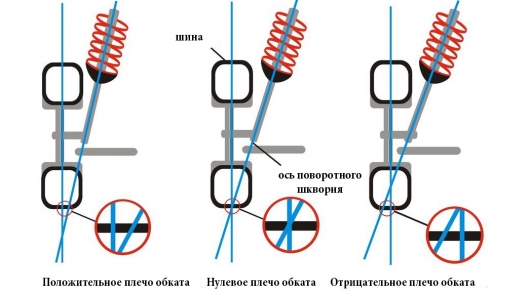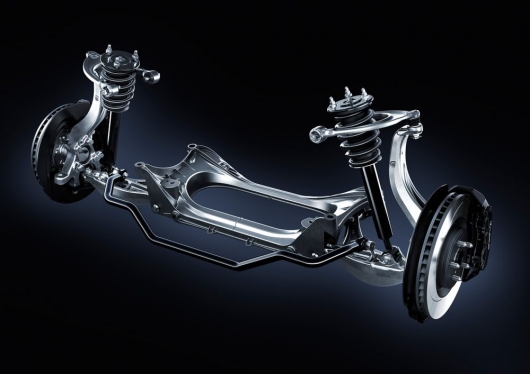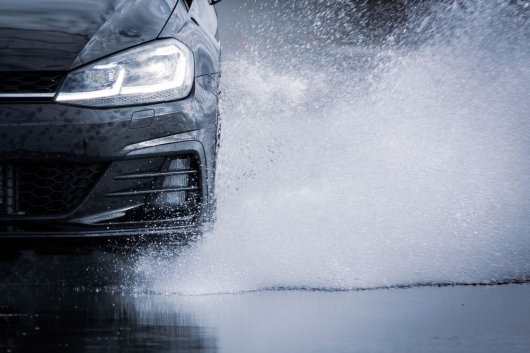What is the radius of the shoulder running and why is it important?
The parameter of the suspension, about which almost nothing is known

When you are “fiddling” with the suspension repairs, experimenting with the size of the wheels or do the setup again raised the suspension, it may be embarrassment that you may have never even heard – it is likely to change the radius of the shoulder running. This “thing” can have a serious impact on your car’s handling.
Without a clear and complete understanding of all the factors influencing the work of the suspension, the wheel location and the adjustment of the geometry, it is easy to make a mistake in setup, which in the end will make your car feel worse than it was before. Thus, to capture the moment, which was made unfortunate mistake quite difficult.
In General, the radius of the shoulder running – this is the elusive, almost mythical setting, standing somewhere on the edge of the key adjustments such as camber, offset and wheel size. In fact, it is determined by the location of the point in space where an imaginary line passing through the centre of the suspension, crosses a vertical line passing through the center of the wheel, these two lines somewhere to meet. It is important that this angle is calculated on the vehicle with no load. For the calculations carried out by the engineers is extremely important.

Note the greater the angle of the suspension relative to the wheels
In General, there are three main versions of the radius of the shoulder:
If two lines intersect exactly on the spot of tire contact with the road, this car has no radius shoulder running.
If the lines intersect below the contact patch, theoretically under the ground, it is called a positive radius shoulder running.
When the two lines converge over the contact patch –is the negative shoulder running.
Depending on these settings, they can seriously affect how the car is driven, accelerates and stops. Different load per axle and drive configurations require different settings, which will be calculated even before the engineers start implementing the desired handling characteristics. Yes, the automakers are a bunch of hard work, and this stage only one of them. Change only one parameter in the suspension, and you trigger a chain reaction that ultimately can negate your main goal.

Radius shoulder running refers to the relative angle between the suspension and the axle of the wheels
At zero radius, the widespread belief is that this setting can make the car feel slightly unstable in the front when cornering and braking.
On the other hand, in a stationary state when the wheel has to rotate the contact patch the maximum spread on the road surface that requires more effort and more wears out tire. Nowadays this kind of setup (with zero shoulder) cars very rare. A little more or a little less, but not zero.
You can, of course, change the zero setting. For example, “slide” wheels with spacers, or install fully adjustable coilovers and the radius can be positive. This will cause the tire to “scrape” along the ground, when cornering, adding uneven wear, reducing its service life. A car with a positive shoulder running can lead on the road is unpredictable: steering wheel when driving irregularities can escape from the hands when driving turns creates a “significant moment that prevent a uniform motion”.
Positive aspect of this configuration is for rear wheel drive cars. To them, this configuration is useful in order to help keep the front wheels in the forward direction, even when you release the steering wheel. Used in sports cars and comes as standard with most designs suspension with double wishbones.

Front axle Volkswagen Scirocco
The positive radius of the shoulder is not conducive to braking, if for any reason, between the sides of the vehicle to operate in various power. For example, if the left wheel has less traction and the ABS system does not allow them to develop maximum force. In this case, the car will try to turn towards the wheel with more grip.
Extreme positive radius shoulder can make the steering very heavy, so that it was really only viable on older cars with very thin tires.
Most of us on the car is negative the radius of the shoulder, because it tends to go hand-in-hand with the settings of suspension McPherson struts. It helps steerable front wheels behave on the road more consistently, which is good for cornering, and overall control of the vehicle if, say, you suddenly pulled one of the front tyres. Another convenient side-effect is that, if you would fly wheels in the water from one side of the vehicle, a negative radius will work against the natural bias of the car, mitigating the effects of the passage of the dangerous section.

Negative radius shoulder safer when aquaplaning
To set up the suspension in a negative shoulder is the most secure option to do it. She (setup) allows you to generate efforts that will minimize any unintended driver of the trend changing direction, which in the case of a positive adjustment may be the place to be.
As a result, vehicles with diagonally split braking systems, if one circuit fails, the remaining braking force on one front and one rear wheel still will not pull the vehicle to one side.
If you change the wheels, change the tire size or made to reconfigure the suspension (put spacers, lowered suspension), make sure you do not forget about such important thing as “the radius of the shoulder.” By the way, this is one reason why our state is so firmly took over tuned cars. Inept tuning can ruin the car’s handling, so much so that he becomes dangerous to travel on public roads.
